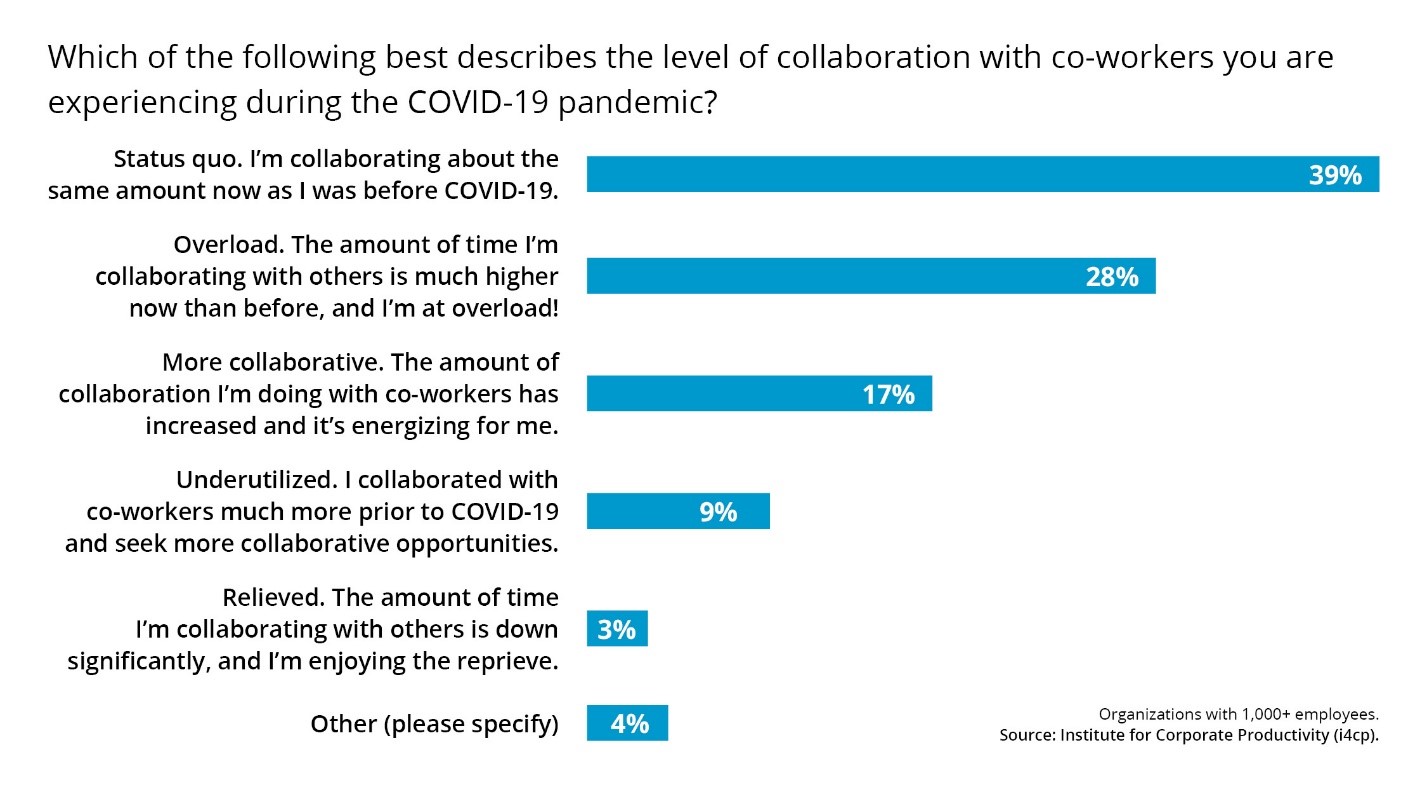The Coronavirus Pandemic & Collaborative Overload

28% of respondents to an i4cp survey report that they are feeling collaborative overload due to higher collaboration demands than before COVID-19.
The top communication / technology culprits contributing to feelings of collaborative overload are video meetings (78%) and email (71%), followed by collaboration platforms such as Slack and Teams (47%).
The concept of “collaborative overload” entered many people’s vocabularies after the cover story with that title, written by Rob Cross, Rob Rebele, and Adam Grant, appeared in the Jan/Feb 2016 issue Harvard Business Review.
In short, while collaboration in the workplace is generally a good thing, too much of it, or collaboration in the wrong ways, can overload individuals and teams, and actually reduce productivity and morale.
Given the significant shifts in work practices for many people due to the COVID-19 pandemic (e.g., more working from home, the use of new tools, more virtual meetings, etc.), the Institute for Corporate Productivity (i4cp) conducted a survey last week of over 200 HR professionals to determine if they were feeling more or less collaborative overload.
While 39% reported that they are collaborating at about the same level as before COVID-19, over one-quarter (28%) said they are feeling overloaded as the collaborative demands on them are much higher now.
But there’s a positive flipside to that—17% said that while they are collaborating more with their co-workers, doing so is energizing for them and not creating a feeling of overload. Only 12% indicated they are collaborating less than before.
When asked which communication / technologies are causing the most collaborative overload angst, it wasn’t surprising that 71% of respondents cited email among their top three problem areas.
This has long been an issue for many people, but a sudden shift to remote work could exacerbate this if the volume of email increases. See i4cp’s email best practices derived from our study on collaboration conducted in partnership with the aforementioned Rob Cross, now at Babson College.
Virtual facetime is the biggest overload culprit—most respondents (79%) indicated the use of video platforms (Zoom, WebEx, etc.) is a top cause of feelings of collaborative overload. As helpful as these platforms are, “Zoom Fatigue” is real for many people. The sheer number of meetings is an issue, with 36% of respondents indicating they are in three-to-four meetings per day during the current crisis, 24% saying they are in five-to-six meetings per day, and 20% are in seven or more meetings daily.
Beyond the sheer number of virtual meetings, another factor is the frequent use of webcams. Unlike in-person meetings, using a webcam means you not only see your colleagues, but also constantly see yourself as well, something we aren’t used to psychologically.
And unique to this pandemic period is the added stress factor of inescapable work/life overlap—trying to manage and be present for virtual meetings while dealing with children at home, partners also working from home, etc.
Collaboration platforms such as Slack and Teams were cited less often (47%) by those surveyed as a primary source of collaborative overload. This could be because they are less problematic than email and video meetings, but they might also simply be less prevalent at many organizations (for now). Their use is increasing significantly during this time of increased remote work, so it will be interesting to track what impact they have on both productivity and collaborative overload in the future.
Relatively few organizations are trying to measure collaboration within their workforces during this pandemic, with frequent pulse surveys being the most common approach (16%), followed by monitoring email and collaborative platform usage (10%). This will likely change, because to the extent increased remote work is here to stay for the foreseeable future, leaders will need to focus on optimizing collaboration and minimizing collaborative overload in order to maximize productivity and reduce employee stress.
Download the full survey results—due to the current global health and productivity crisis affecting everyone, i4cp is making all related ongoing research publicly available.






